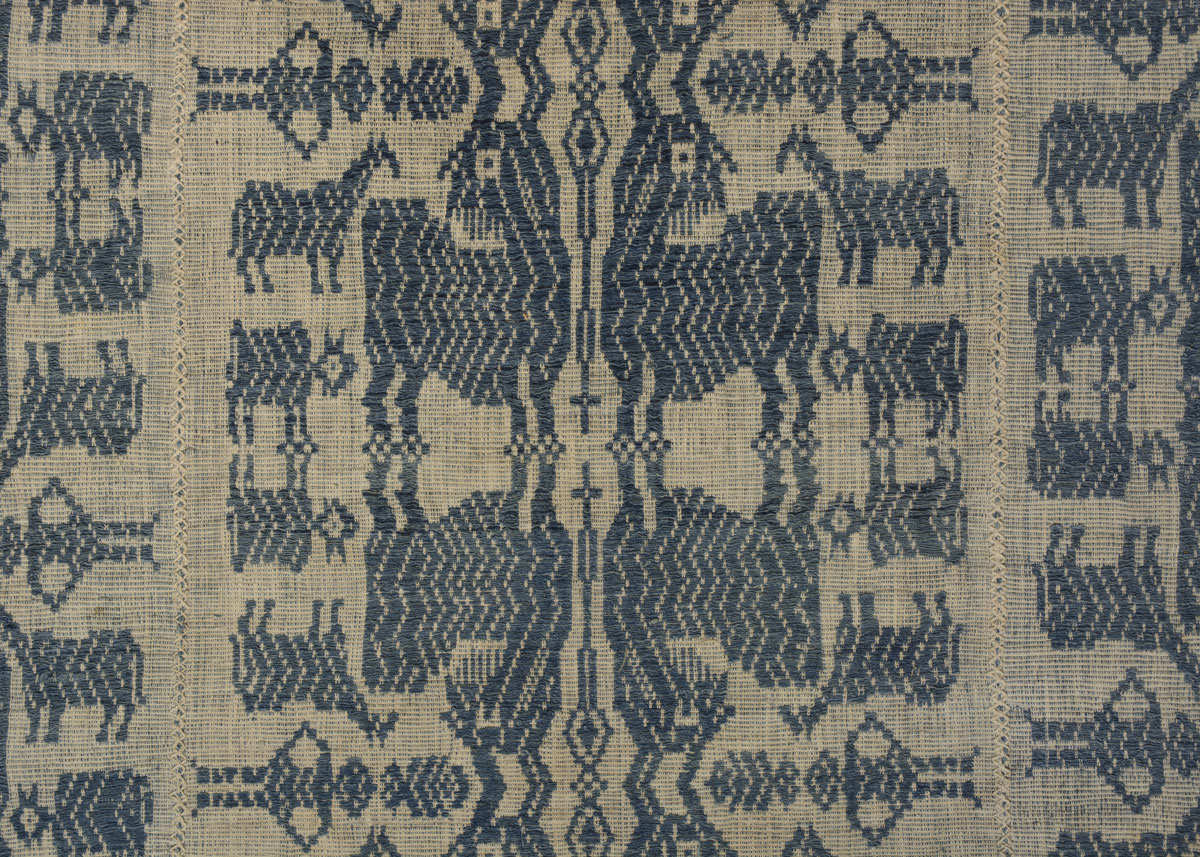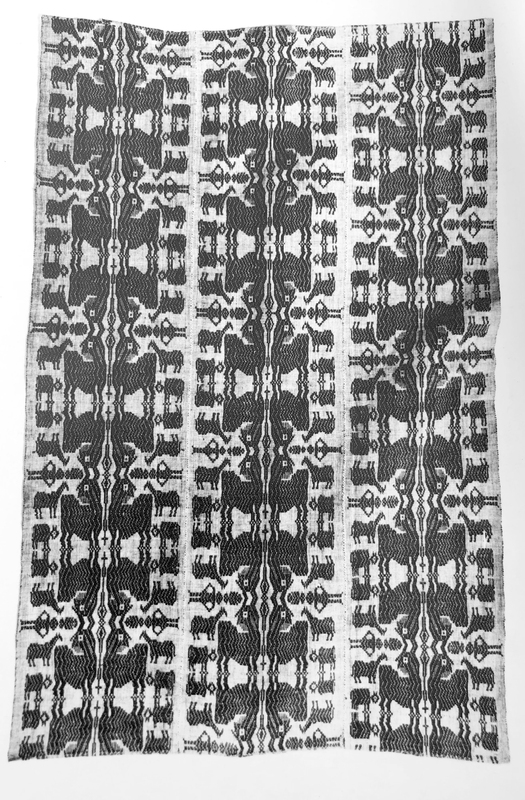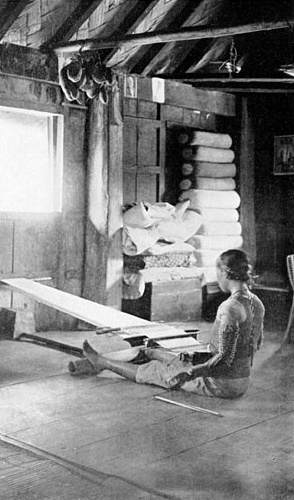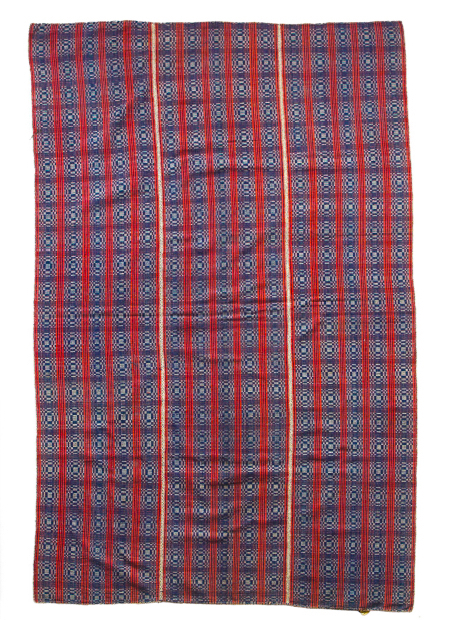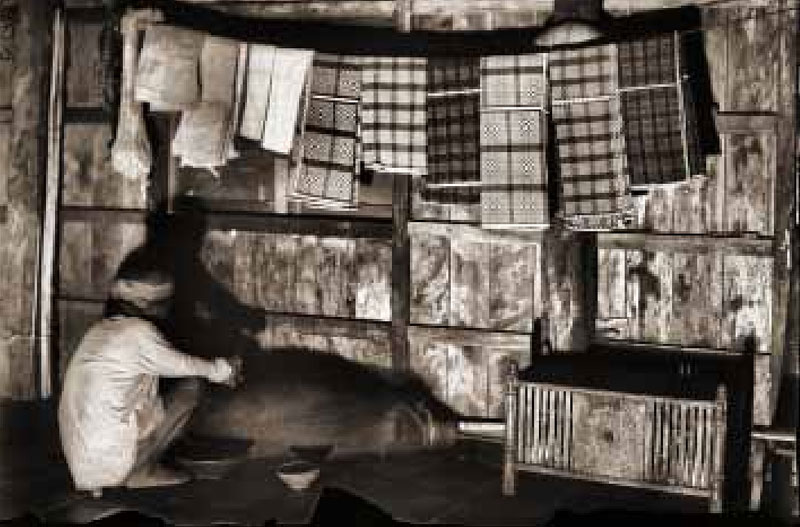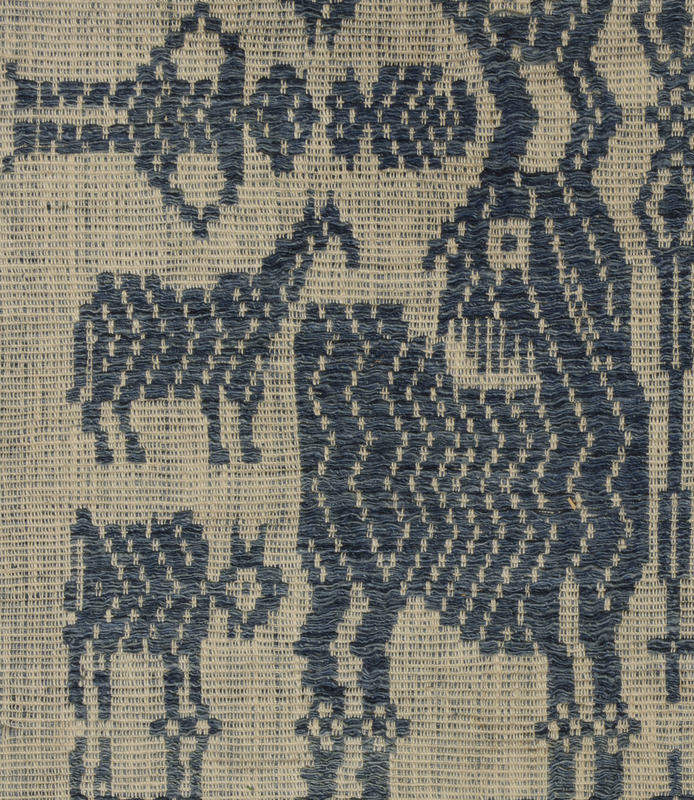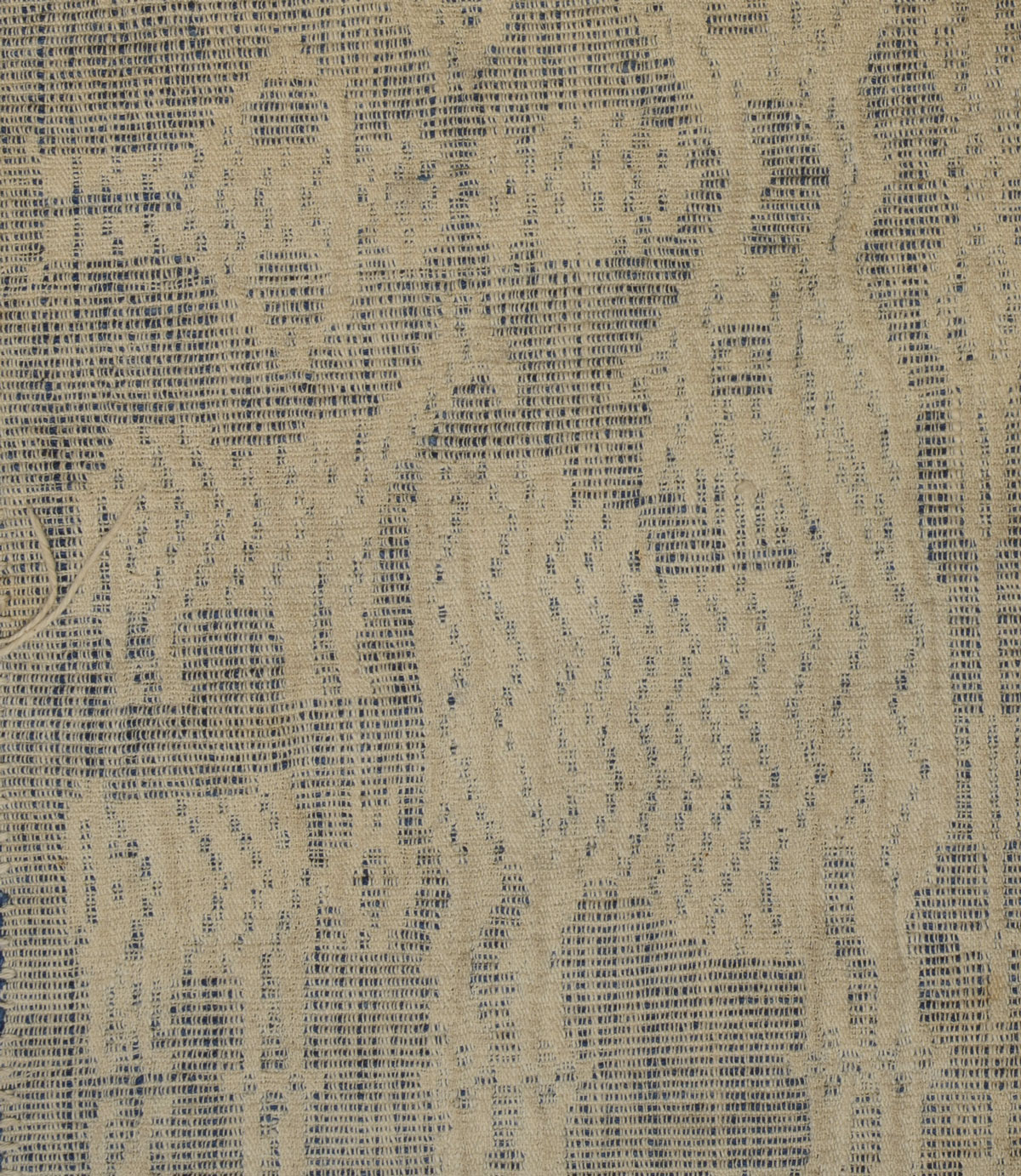Choice
Exhibit Description
Inflection
The verb pilì, “to choose or select”, exists in many of the Philippines’ 170+ languages. The word comes up in these reflections on a single blanket, which belongs to a category designated pinilian. “Having been selected” (or chosen)—or the outcome of a process of selection or choice — is the signified. The communities who speak the languages collectively called Itneg,(1) or Tingguian, and Ilocano, living in contiguous geographies in the Philippine north, understand the word and its root as both the generic root shared with the rest of the Philippine peoples, and with particular reference to a technique of making in their textile arts.Pilì, the root (pronounced pilih in other parts of the Philippines), creates a textile category that is, on one level, straightforward in its reference to their version of supplementary weft weaving; and on another, more elusive level, the metaphysical registers of acts of selection. For the Tingguian/Itneg and the Ilocano (language and people are named similarly, as elsewhere in the archipelago), pinilian textiles are a singular group of what is nevertheless a wide range of visual-tactile outcomes of a woven-in patterning technique.
Pinilian blankets are still woven today, indeed with remarkable competence, in the region from where the blanket was collected in 1908 to be brought to Chicago’s Field Museum of Natural History. The word does not necessarily assert object specialness. Rather, the reference is to technique: the fabric is created by mathematical precision in the deployment of thousands of string heddles. Called supplementary weft weaving, the term in English focuses on the insertion of additional weft threads—in this northern Philippine region, typically thicker-ply and differently-colored threads from the regular weft forming the basic matrix of the cloth — in discontinuous lines that thus forms patterning. The English technical term therefore construes the textile “sense” as its patterning, endeavoured by an act of addition; of supplementation.
The term pinilian is differently inflected by those who use it. It is pattern-setting that is foregrounded: the exact and exacting “programming” of the sequence of weaving actions to create a composition imagined a priori. This work is undertaken only by virtuosos, who prefigure the outcome by selecting a precise sequence of sets of warp threads. The procedure eludes verbalization. So measured is it in both abstract (arithmetical) and material (visual-kinetic) registers, that narrativization inevitably flounders in the mass of technical detail. And yet it is the combination of utterly determined repetitiveness and an eye/feel for quick shifts of sequences that is precisely the way images in the weaver’s imagination are translated into math; and into cloth. A technical summary is the way into the metaphysical registers of this tradition.
Programming
Each set involves the threading through of individual warp threads into tiny nooses of thread that are all, in turn, attached to a bamboo heddle stick, that can therefore raise all threads of each set together. The different sets are lined up horizontally on the loom to be raised one after another. Upon raising, an opening is created (textile scholars call it the “shed”) so that the supplementary weft can be inserted on a per set basis and laid well on, in, and through the warp lines. Once inserted, the discontinuous supplementary weft line is beaten into a fixity with a flat, elongated, smooth instrument that is also inserted through the warp to open the shed per set. The beater thus opens and closes the shed before and after the supplementary weft is introduced into the warp.Hence the pre-conceived composition is programmed to materialize via a mathematical projection, in the mind of the pattern-setter, as to the exact number and location of threads selected to constitute a set of warp threads; and then, the exact number and sequence of sets that are individually raised to receive the supplementary weft. The principle and activity are conceptually similar to that for a Jacquard loom, which, not incidentally, prefigured the computer. To create the pinilian, a normally competent weaver can do the actual weaving, because the virtuoso procedure would already have been accomplished by the pattern-setter.
The maker of the exceptional blanket showing deer, calves, and men, used cotton yarn dyed with indigo (Indigoferia tinctoria) to serve as the supplementary weft. The composition is both symmetrical and asymmetrical and the pattern-setting very ambitious: it may have required upwards to a hundred heddle sticks, each with a different set of warp threads, to set the imagery. Consisting of the traditional severe geometry which nevertheless, in this case, forms curvilinears through stepped outlines of the figures, the composition appears to be a much higher order of ambition than the Ilocano cloths featuring peacocks, large double headed (Hapsburg) eagles, and family names. These Ilocano cloths are created as supplementary weft floats, or discontinuous supplementary weft, which lessens the mathematical calculations necessary for a composition with no open field, as in the Tingguian/Itneg case.
What makes the Field Museum piece very special indeed is that, having been collected in Patoc, Abra in 1908, it was most certainly created on a backstrap loom. The Ilocano pinilian pieces have been woven on the Ilocano floor loom for more than a century; perhaps much more. And extraordinary fineness of weave achieved on the backstrap loom cannot be matched on the floor loom —because it is typical for the semi-industrialized Ilocano loom to have wider widths between the teeth of the weaving combs; wider widths from selvage to selvage, which leans the tradition in the direction of looser weaves; and the precision that is only possible with direct tactility of eye-hand coordination of the backstrap loom.
Collecting the Tingguian
In the Field Museum records, the blanket — generically, owës — was collected by the American anthropologist Fay-Cooper Cole, who led the Robert F. Cummings Expedition of 1907 – 1908. A further note says that it was Mabel Cook Cole, Fay-Cooper’s wife and herself an anthropologist, who convinced the owner to part with it after trying for months. It would have then been of considerable value to the owner, therefore; an idea reinforced by the object identification as a ceremonial blanket, “such as hung over the dead”, wrote Cole.(2) Of the over 5000 articles collected by the expedition, the blanket is among the most compelling.The expedition lasted four years and covered, among other places visited by the Coles and other anthropologists, the still undivided Davao Province, Mindoro, Abra, and Bukidnon, collecting material for a Philippine exhibition at the museum. The Patoc owës itself is among a number from the same village, located along a curve of the Abra River very much in the interior of the province of this name. Patoc is adjacent to Manabo which is at the outer reaches of the home geography of the Itneg language groups.
Cole and company were the early 20th century group following a number of other travelers to these parts, beginning with conquistador Juan de Salcedo in 1572, who observed large fields of rice and cotton. The German chemist and ethnographer Alexander Schadenberg visited Patoc as well, between 1885 and his death in Vigan in 1896. Photographs of Patoc residents, whom he, like Cole after him, also called and spelled Tinguianes (Tinguians), together with a remarkable number of others of Cordillera peoples, were published in Dresden in 1891. (3) Schadenberg wrote: “Los Tinguianes de la rancheria de Patóc son muy ricos y las mujeres llevan muchos adornos de plata y de oro de trabajo antiguo y del país y de una hechura que parece de mucho á la filigrana.”
This rich Patoc Tingguian and the other communities who were identifiable in the 19th and early 20th centuries via this exonym —or the endonym Itneg —were known in the European scientific and travel literature prior to the American scientific foray into Abra. Schadenberg and Adolf Bernhard Meyer traveled more extensively than Cole did in the Cordilleras. And while Cole stayed longer in Abra, Schadenberg’s collection —scattered in museums in Dresden, Vienna, Leiden, and Berlin—contributed to the divisions of ethnographic fields that were to be institutionalized and popularized by Ferdinand Blumentritt in Philippine Studies(4). Schadenberg’s dispersed collection includes 19th century pinilian blankets from Abra (and a schambinole, which is preliminarily translated here as a pubic cover, from Patoc specifically), with the collection of the Weltmuseum Vienna.
Prior to the German scientists, the French horticulturist and traveler Paul de la Gironière walked through Abra in the second decade of the 19th century, subsequently writing about headhunting and a “brain feast” among the Tinguian of Palan, Laganguilan, and again Manabo.(5) He mentions bark loincloths and the presence of cotton. Present at a wake in the “large village” of Manabo, Gironière wrote: “The deceased sat in the middle of his cabin upon a stool; underneath him, and at his side, fires were burning in enormous chafing-dishes” Cordillera-wide practice that survived until a few years ago. The Frenchman, typically detailed in his descriptions, did not observe a display of blankets. About a century later, Cole took a photograph of the corpse of a man named Malakay, flanked by such an exhibition; specifically of pinilian blankets. (6)
Symmetry
It is possible that the accumulation of pinilian blankets among the Tingguian/Itneg and the exhibition of these during death became part of death rituals within the century between Gironière’s and the Coles’ visits. Rather than textile display, wealth was much more obviously exhibited as possession of Chinese ware, masses of glass beads, and ritual accoutrements with shell and ivory elements, for a longer period of time that should include intensified Chinese and Japanese exchanges with the peoples of western seaboard of northern Luzon before the encounter with Spain. And while cotton itself was cultivated in these parts for at least half a millennium, widespread use of the pinilian category does not necessarily align with the same time line. And the timelines for pinilian weaving for the Ilocano speaking populations and the Itneg speaking populations are unlikely to be coincident.Pinilian blankets fascinate, not for claims to antiquity, but for the clarity of the focus on choice in culture making. The Field Museum’s pinilian in this exhibit is a particularly intriguing example of choice as metaphoric of the larger questions any culture tries to resolve, about the absorption of external forces into systems internal to a language group. This kind of inquiry will have to begin, again, with the selection of sets of warp threads to create a pre-imagined composition. Such selection is made efficient by regularity (for example, sets of odd numbers, or all counts of tens, and so forth). But to ambition the likeness of deer, carabao calves, and humans ordered in a composition, means that the selection of warp threads to form sets will not make for an efficient regularity of count.
Only the mirroring of the motifs makes for numerological regularization. But, looking at the blanket as a whole integrated composition, the mirroring could not have been endeavoured as a labor-saving device. The creation of symmetry with asymmetrical elements is so expertly achieved, this could not have been the work of a weaver given to short cuts. Her choice, in this case, was the more challenging trajectory. Given that vaguely figurative patterns are always associated with ideas coming from outside the aesthetic worlds of Philippine peoples, and that extremely conservative Philippine weaving traditions maintain symmetrical geometries —indeed bilateral symmetry—the weaver set the pattern to absorb figuration into a dyadic visual structure.
The blanket represents a clear choice to absorb an external concept, that of figuration of reality, into a complex matrix that is in essence bilateral. That choice was executed in the expert selection of warp thread sets that had to have a higher order of differentiation from each other than would typically be needed to create matrices. Having done so, the weaver makes plain that choice can be regarded as central to the construction of her, or any other, culture. It might be said, as she may be “saying” in this textile, that a people are a people as defined by the choices they make: ideas to articulate better than other ideas; widely preferred things; idealized relationships. In the Philippines, such construction proceeded with a particular inflection that, arguably, endured through millenia.
It was a proclivity — it can be called choice — for bilateral symmetry. Of this, entire books will have to be written.
Endnotes
1 Ethnologue of the Summer Institute of Linguistics identifies five separate Itneg languages: Itneg Binongan, Itneg Inlaod, Itneg Maeng, Itneg Madasiit, and Itneg Modayan. Speakers of these languages are collected called the Itneg people, or the Tingguian. The latter is a Hispanicized rendering of the Malay term tinggi, “high”, referring to peoples of highlands.
2 Cole, Fay-Cooper, The Tinguian: Social, Religious, and Economic Life of a Philippine Tribe, Chicago: Field Museum of Natural History, 1922, p. 34.
3 Schadenberg, Alexander and A. B. Meyer, Album de Tipos Filipinos. Luzon Norte, Dresden: Stendel y Markert, 1891.
4 Blumentritt, Ferdinand, Alphabetic List of the Native Tribes of the Philippines, Berlin: Zeitschrift far Erd- kunde, 1890.
5 Gironière, Paul de la, Vingt années aux Philippines, London : James Vizetelly : Henry Vizetelly, [1853?]
6 Unless the man’s name was Ma, “Malakay” does not appear to be a name. Lakay is an honorific used universally in northern Luzon, Philippines, for a respected male elder.
Explore items in Exhibit
Blanket (Owës)
Name: Owës( annotated from Orves as indicated in the Field Museum online catalog, May 1, 2021.)
Old, very rare blanket. Designs in raised blue thread -on one side only- Used to hang above the dead and to offer to the spirits in ceremony. | Notes:…
Blanket (Owës)
The fabric consists of cotton (plain weave; warp and weft threads in dark-blue, white, and red); three panels are assembled lengthwise. The consistently white and dark-blue geometrical pattern is called kosikos (Kron-Steinhardt 1991: 179) or binakel…
